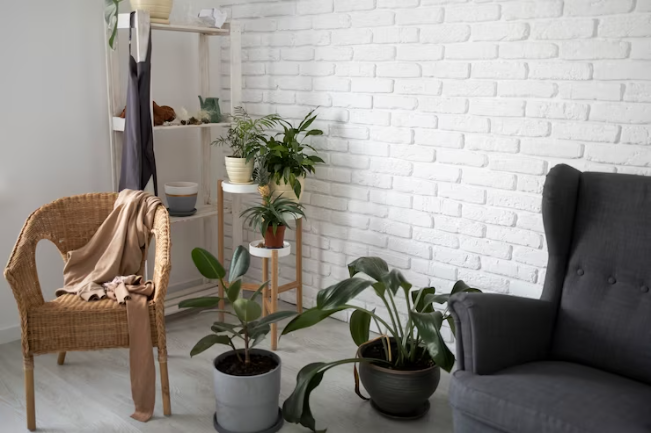Productivity And Well-Being: Do you know that the average person spends approximately 90% of their time indoors, with a significant portion of that time being spent in their homes?
With such a large amount of time being spent in one place, it’s no surprise that the environment in which you live can have a significant impact on your productivity and well-being. In fact, studies have shown that the design and atmosphere of your home can have a profound effect on your overall health and happiness.
According to a survey conducted by the Environmental Protection Agency, Americans spend 87% of their lives indoors, with 69% of that time spent in their homes. This means that the design and atmosphere of your home can have a significant impact on your daily life, influencing your productivity and well-being.
From the amount of natural light in your home to the quality of the air you breathe, every aspect of your home environment can affect your mental and physical health. In this article, we will explore the influence of home environment on productivity and well-being and provide tips for designing your home for optimal performance and happiness.

The Psychological Effects of Home Environment on Productivity
You’re probably unaware of how much your surroundings can affect your ability to focus and get things done. The psychological effects of home environment on productivity are real and can make a significant impact on your day-to-day performance.
For example, color psychology suggests that certain colors can evoke different emotions and moods. A room painted in blue can promote calmness, while a room painted in red can increase energy levels. By strategically choosing colors for your home office or workspace, you can create an environment that promotes productivity and focus.
Organizational strategies are also crucial for boosting productivity in a home environment. Clutter and disorganization can be major distractions, making it difficult to concentrate on tasks at hand. By implementing organizational strategies such as decluttering, using storage solutions, and creating a designated workspace, you can create a more efficient and productive environment.
Additionally, taking breaks and incorporating relaxation techniques such as meditation or yoga can help reduce stress and increase overall well-being, further enhancing productivity in a home environment.
By paying attention to the psychological effects of your home environment, you can create a space that promotes productivity, focus, and overall well-being.
Designing Your Home for Optimal Productivity
Get ready to transform your living space into a powerhouse for getting things done and feeling amazing. Space optimization is an essential factor in designing a productive and comfortable home environment.
Start by clearing out clutter and unnecessary items that take up valuable space. A clean and organized space allows for better focus and reduces stress levels.
Next, invest in ergonomic furniture that supports good posture and reduces discomfort. A comfortable chair and desk can make all the difference in your productivity levels.
Additionally, consider the placement of your furniture. Position your desk near a window for natural light and a view of the outside world. This can help reduce eye strain and increase mood-boosting benefits.
By optimizing your home space with ergonomic furniture and an organized layout, you can enhance your productivity and well-being.
Enhancing Well-being through Home Environment
Transforming your living space is like creating a sanctuary for your mind and body, where you can recharge and thrive.
One way to enhance your well-being through your home environment is by understanding color psychology. Colors have the power to affect our mood and emotions. For instance, blue hues have a calming effect while yellow tones promote happiness and positivity.
Incorporating these colors into your decor can help create a more peaceful and uplifting atmosphere in your home. Another way to improve your well-being through your home environment is by incorporating indoor plants.
Plants not only add aesthetic appeal to your living space but also have numerous health benefits. They purify the air by removing toxins and increase oxygen levels, which can boost productivity and concentration.
In addition, studies have shown that being around plants can reduce stress and improve overall mood. Adding a few potted plants to your home office or living room can help create a more relaxed and rejuvenating environment.
By incorporating color psychology and indoor plants into your home, you can transform your living space into a sanctuary that promotes well-being and productivity.
The Importance of Natural Light and Air Quality
One way to make your home feel more inviting and comfortable is by letting natural light in and improving the air quality. Biophilic design, which incorporates natural elements or patterns into the built environment, has been shown to have a positive impact on physical and mental well-being.
Exposure to natural light has been linked to improved mood, increased productivity, and better sleep. It can also help regulate the body’s circadian rhythms, which can have a significant impact on overall health.
In addition to natural light, indoor plants can also contribute to a healthier home environment. Plants have been shown to improve air quality by removing toxins and pollutants from the air. They also increase humidity levels, which can help alleviate respiratory issues and dry skin.
Incorporating plants into your home can also have a calming effect and improve overall mood. By incorporating biophilic design elements like natural light and indoor plants, you can create a more comfortable and healthy home environment that promotes productivity and well-being.
Managing Noise Levels in Your Home for Increased Productivity
If you’re looking to enhance your focus and create a peaceful atmosphere, managing the noise levels in your home is key. Excessive noise can be a major distraction and can affect your productivity and overall well-being.
Fortunately, there are several soundproofing solutions that can help you create a quiet and peaceful environment in your home. One effective way to reduce noise is by using sound-absorbing materials such as curtains, carpets, and acoustic panels. These materials can help absorb sound waves and prevent them from bouncing off hard surfaces, which can contribute to noise levels in your home.
Additionally, you can consider installing soundproof windows or doors to block out external noise. By managing the noise levels in your home, you can create a more peaceful and productive environment that can help improve your overall well-being.
Related Article >> https://harmonytweets.com/optimizing-your-morning-routine-for-a-productive/
Frequently Asked Questions
What are some common misconceptions about the impact of home environment on productivity and well-being?
Stop believing the lies. Common misconceptions about the impact of home environment on productivity and well-being are running rampant. It’s time to set the record straight.
While some might believe that working in a cluttered space is more creative or that a quiet environment is the only way to be productive, the truth is that a conducive environment can have a multitude of benefits. From reducing stress levels to increasing focus and motivation, a well-designed and organized workspace can significantly improve your overall well-being and productivity.
So, don’t fall for the false promises of a messy, disorganized environment. Take charge of your space and experience the benefits of a conducive environment today.
How do cultural factors and personal preferences affect the way people design their homes for productivity and well-being?
When designing your home for productivity and well-being, it’s important to consider your cultural influences and personal preferences. Cultural factors can play a significant role in how you view and utilize your living space.
For example, in some cultures, it may be customary to have separate spaces for sleeping and working, while in others, it may be common to have a multi-purpose room. Personal preferences are also important to consider, as everyone has their own unique needs and preferences when it comes to their living environment.
Some may prefer a minimalist, clutter-free space, while others may find comfort in a cozy, eclectic atmosphere. By taking these factors into account, you can create a home environment that caters to your individual needs and promotes productivity and well-being.
Can certain colors, textures, or patterns in home decor have negative effects on productivity and well-being?
When it comes to choosing colors, textures, and patterns for your home decor, it’s important to keep in mind the principles of color psychology.
Certain colors can have positive effects on your mood and productivity, while others can lead to sensory overload and negative impacts on your well-being.
For example, bright and bold colors like red and orange can be energizing and stimulating, but too much of these colors can be overwhelming and cause stress.
On the other hand, softer colors like blue and green can promote calmness and relaxation, making them ideal for spaces where you want to unwind and recharge.
When it comes to textures and patterns, it’s important to strike a balance between visual interest and sensory overload.
Too many busy patterns or textures can be distracting and make it difficult to focus, while a lack of texture and pattern can make a space feel sterile and uninviting.
By considering the principles of color psychology and sensory balance, you can create a home environment that supports your productivity and well-being.
What role does technology play in creating a productive and healthy home environment?
If you’re looking to create a productive and healthy home environment, it’s important to consider how technology integration and sustainable practices can help.
By incorporating smart home devices, you can automate tasks and create a more efficient living space. For example, a smart thermostat can adjust the temperature of your home based on your schedule, while a smart lighting system can adjust to your preferences and help regulate your sleep cycle.
Additionally, by implementing sustainable practices such as using energy-efficient appliances and reducing waste, you can not only save money, but also reduce your carbon footprint.
By combining technology and sustainability, you can create a home environment that is both productive and environmentally conscious.
How do different types of living spaces (e.g. apartments, houses, shared living) affect productivity and well-being, and what can be done to optimize these environments?
To optimize your home workspace, it’s essential to consider a few key factors.
Firstly, natural lighting is critical for productivity and well-being. Ensure your workspace has access to natural light, or if that’s not possible, invest in light bulbs that mimic natural light.
Secondly, ergonomic furniture is a must-have to maintain physical health. Invest in a comfortable chair, desk, and monitor that can be adjusted to your body’s needs.
However, noise pollution and air quality can significantly impact your productivity and well-being. To reduce noise, try noise-cancelling headphones or soundproofing your workspace. Additionally, air quality can be improved by adding plants or using an air purifier.
By optimizing your home workspace with natural lighting and ergonomic furniture and addressing noise pollution and air quality concerns, you can increase your productivity and well-being.
Conclusion
In conclusion, the impact of your home environment on your productivity and well-being can’t be overstated. You’ve learned that the psychological effects of your surroundings can significantly affect your ability to focus and get things done.
By designing your home for optimal productivity, you can create an environment that supports your goals and helps you achieve your full potential.
Furthermore, enhancing your well-being through your home environment can have a profound impact on your overall quality of life. Every aspect of your home, from natural light and air quality to managing noise levels, can contribute to your physical and mental health.
So take the time to carefully consider your home environment and make any necessary changes to ensure that it supports your productivity and well-being. Remember, your home isn’t just a place to live, but a space that can help you thrive and reach your full potential.

